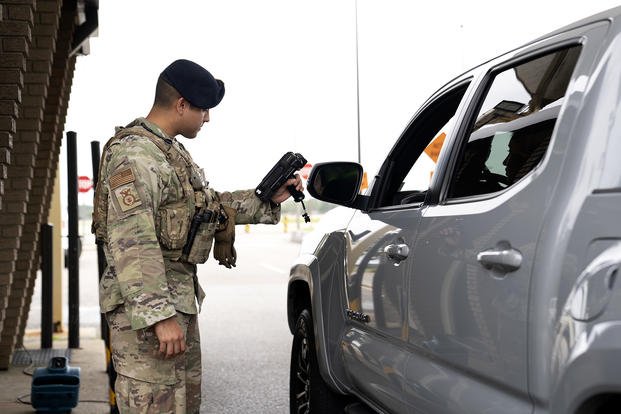Military installations across the country are increasing security measures and suspending certain base visiting privileges following attacks by one current and one former service member last week in New Orleans and Las Vegas.
Bases on Friday began announcing the suspension of the Trusted Traveler Program — an initiative that allows vetted Defense Department personnel to bring people in their vehicle through installation gates and onto bases. The move to suspend the program until further notice was ordered by U.S. Northern Command and applies to all bases, facilities and units in North America, including Alaska, within its area of responsibility.
“Drivers should expect delays and random inspections at entry gates as we enhance the security posture of our installation to ensure our ability to project combat power when and where required,” a notice from Marine Corps Base Quantico said.
Read Next: Green Beret in Las Vegas Bombing and New Orleans Attacker Had Brief Overlap in Military Careers
Various bases across the country also announced there would be random inspections and 100% identification checks as well. The Trusted Traveler Program applied to Defense Department identification card holders — such as Common Access Cards or Defense Biometric Identification System cards — and allowed them to escort people onto base.
Now, those without those identification cards will be required to obtain a base pass from an installation’s visitor center to get past the security gates. The Trusted Traveler Program cut through that paperwork and allowed traffic to move more steadily in front of installations.
“The increased force protection measures directed by USNORTHCOM are a prudent measure to ensure the safety and security of our installations and personnel,” Maj. Jennifer Staton, a Department of Defense spokesperson, told Military.com.
It is not clear how suspending the Trusted Traveler Program is connected to the ongoing investigations into the New Orleans and Las Vegas attacks. Both men would have likely been able to access military bases given their current and former service.
Shamsud-Din Jabbar, a former Army soldier, drove a rented truck onto Bourbon Street in New Orleans and killed 14 people before being killed by police. Master Sgt. Matthew Livelsberger, an Army Green Beret, detonated a Tesla Cybertruck in front of the Trump International Hotel in Las Vegas, Nevada, injuring seven bystanders. He died from a self-inflicted gunshot wound inside the vehicle prior to the explosion, law enforcement officials announced.
Both their New Year’s Day attacks were seemingly uncoordinated.
Military.com reported that Livelsberger left a note following his attack calling his actions a “wake-up call” for the country. Jabbar flew an Islamic State terrorist group flag from the truck he used in his deadly rampage.
Staton told Military.com that the Department of Defense was “not aware of any threats to installations at this time.”
Retired Air Force Col. John Probst, a former Security Forces officer and the executive director of the nonprofit Air Force Security Forces Association, told Military.com in an interview Monday that suspension of the Trusted Traveler Program in the wake of those New Year’s Day attacks helps commanders know who is on theirF base and ensures more scrutiny overall.
But Probst added the measure also signals to potential attackers that things are no longer routine, and are more uniform across all bases.
“If you’ve got bad actors out there and they see that one person only showing an ID and, now, next week, everybody’s showing an ID and every 10th car gets opened up and they look in the trunk and under the hood, the signal you’re sending is it’s not the same as it was yesterday,” Probst told Military.com. “There’s more alertness being paid to those coming and going, and you never know who’s watching.”
U.S. Northern Command has not said when the Trusted Traveler Program might return or when security measures may become less restrictive.
Related: Green Beret Who Detonated Cybertruck Left Note Calling Attack a ‘Wake-Up Call’
Story Continues
Read the full article here

